The research on new materials (aluminium, composite), on penetration in water, on engines and materials to make engines lighter lead the yards to develop a new kind of ferries:
monohull or catamaran, fast ferries steam at 30 knots or more when standard ferries have a maximum speed of 25 knots.
Fast ferries are often limited by the waves height ; some fast ferries now carry cars but, at the difference of conventional ferries, except some ones, they cannot carry buses and trucks. According to the zones of navigation, a catamaran or a monohull will be more advantageous: for the same capacity of 500 passengers and 150 vehicles, will be needed a catamaran of 80 m of length or a monohull of 100 m of length. For the Mediterranean Sea, with short waves, a monohull will run better in the sea than a catamaran of the same capacity. Thus, first fast ferries were built as catamarans for the Northern Sea, i.e. the Channel, the North Sea, the Baltic Sea. |
|
| The Norwegian catamaran GIBLINE I ex-CONDOR 6 was built
by Westamarin Varv, Mandal, Norway in1980 ; powered by two Avco Lycoming TF40S waterjet turbines,
at a speed of 30 knots, 238 passengers.Chartered by the British Condor Ferries
she was used in the service between Jersey, Guernsey to St Malo, France. |
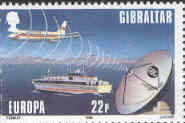
|
|
|
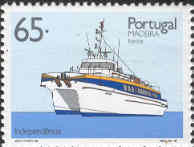
|
Launched
under the name GIMLE BIRD in 1981,
sold
to Government of Madeira in 1984,
the
catamaran ferry INDEPENDENCIA
built by Westmarin
sails in a daily service from Funchal to Vila Baleira, and can make the
journey in 90 minutes. |
| Fjellstrand A/S built its first catamaran in 1976 and launched the first Flying Cat in 1989. By 1999, 59 crafts have been built. |
|
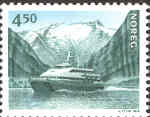
|
KOMMANDØREN built in 1990 in Norway (40,00 x 10,10 x 1,46 m), for 282 passengers, is powered by two MTU 16V396 TB 84 Diesel of 5400 hp at 36 knots and serves on Sogn/Bergen with other sister ships. The propulsion concept of this Flying Cat 40 includes two Diesel engines and two waterjets. |
|
| Designed to carry 700 passengers, CHEUNG KONG was built by Vosper Thorneycroft for service in Hong Kong with the operator Shun Tak Shipping. The vessel was fitted with four 16 cylinder 3,000 bhp, driving variable pitch propellers, to give a top speed of 28 knots. |
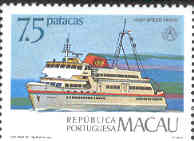
|
|
|
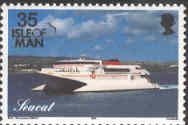
|
Built in 1991 by International Catamaran Designs Pty Ltd (Incat Australia) for Sea Containers,
SEACAT was the worlds' first car-carrying catamaran (3003 GRT, 450 passengers, 85 cars). The original 74 metre craft have subsequently been joined in Sea Containers' fleet by a new 81 metre length SeaCat design, also built by Incat. |
|
This water-piercing catamaran in a all-welded structure, with most plating thickness 6 to 20 mm. Superstructure is built separately and fitted to the hulls with resilient mountings. SeaCat's design with long twin narrow hulls and aluminium construction enables it to achieve higher speeds than conventional ships. Medium-speed diesels directly drive 4 water-jet units with steering and reversing system. SeaCats cruising speed is 35 knots, with a top speed of 40 knots.
Water-piercing catamarans have a central stem which changes the catamaran into a trimaran when passing a wave, reducing thus the vertical accelerations while keeping the lateral returns proper to catamarans. In this type of craft, the side hulls pierce the waves to smooth the ride and a large centre hull normally rides clear of the water, but stops nose-diving in heavy seas and takes the strain if there is not enough buoyancy in the side hulls in heavy seas.
The introduction of SeaCat on routes in Northern Europe set new standards of speed and service, cutting existing journey times in half and often increasing demand for ferry travel overall. |
| Built in 1992 at Hobart by Incat, HSC CONDOR 10
is also a 74m water-piercing catamaran and runs at 39 knots with 580 passengers and 90 cars ; she was in service from 1994 on Weymouth - Guernsey - Jersey, chartered by several companies and back on Jersey - Guernsey - St. Malo from 2002. |
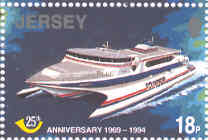
|
|
|
|
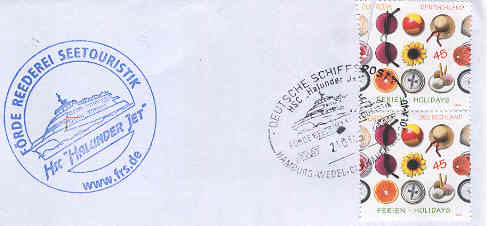
|
| HALUNDER JET, with 4 Waterjets Type KaMeWa
Typ 63 SII, built in 2003 by Norwegian yards Fjellstrand, links Hamburg, Wedel, Cuxhaven
and Helgoland. |
|
| The transport by high speed ferries is going to develop on the short and average distances without replacing the traffic of the classic vessels: sensitive to the state of the sea, few entertainments on board, not or little temporary space outside limit the development to the detriment of conventional ferries, today often called cruise ferries with swimming pool(s), cinemas, restaurants. |
|
Main sources:
http://www.foils.org gives detailed technical information about the hydrofoils design and usage.
http://perso.wanadoo.fr/fcapoulade/index.htm is a French site dedicated to fast ferries
Jane's high-speed marine transportation 2000-2001 gives also technical informations. |







 MENU
MENU 
